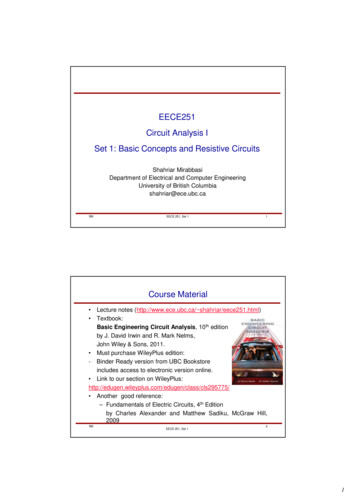
Transcription
EECE251Circuit Analysis ISet 1: Basic Concepts and Resistive CircuitsShahriar MirabbasiDepartment of Electrical and Computer EngineeringUniversity of British Columbiashahriar@ece.ubc.caSMEECE 251, Set 11Course Material Lecture notes (http://www.ece.ubc.ca/ shahriar/eece251.html)Textbook:Basic Engineering Circuit Analysis, 10th editionby J. David Irwin and R. Mark Nelms,John Wiley & Sons, 2011. Must purchase WileyPlus edition:- Binder Ready version from UBC Bookstoreincludes access to electronic version online. Link to our section on /cls295775/ Another good reference:– Fundamentals of Electric Circuits, 4th Editionby Charles Alexander and Matthew Sadiku, McGraw Hill,2009SMEECE 251, Set 121
Evaluation Assignments10% Midterms40% Final Exam50%SMEECE 251, Set 13MotivationElectrical circuits seem to be everywhere!SMEECE 251, Set 142
OverviewIn this slide set we will review basic concepts,electrical quantities and their units, circuit elements,and basic circuit laws.Reading Material: Chapters 1 and 2 of the textbook.Note: Some of the figures in this slide set are taken from the books (R.Decarlo and P.-M. Lin, Linear Circuit Analysis, Second Edition, 2001,Oxford University Press) and (C.K. Alexander and M.N.O Sadiku,Fundamentals of Electric Circuits, Second Edition, 2004, McGraw Hill)SMEECE 251, Set 15What is an Electric Circuit? In electrical engineering, we are usually interested intransferring energy or communicating signals from one point toanother.To do this, we often require an interconnection of electricalcomponents.“An electric circuitcomponents.” SMisaninterconnectionofelectricalTypical circuit or electrical components that we will see in thisyear:batteries or voltage sources, current sources, resistors,switches, capacitors, inductors, diodes, transistors, operationalamplifiers, EECE 251, Set 163
What is an Electric Circuit? According to Merriam-Webster Dictionary:“The complete path of an electric current including usually the source ofelectric energy.” According to Encyclopedia Britannica:“Path that transmits electric current.”“A circuit includes a battery or a generator that gives energy to thecharged particles; devices that use current, such as lamps, motors, orelectronic computers; and connecting wires or transmission lines.Circuits can be classified according to the type of current they carry(see alternating current, direct current) or according to whether thecurrent remains whole (series) or divides to flow through severalbranches simultaneously (parallel). Two basic laws that describe theperformance of electric circuits are Ohm's law and Kirchhoff's circuitrules."SMEECE 251, Set 17A Simple CircuitSMEECE 251, Set 184
A More Complicated CircuitA Radio ReceiverSMEECE 251, Set 19System of UnitsThe International System of Units, or SystèmeInternational des Unités (SI), also known as metricsystem uses 7 mutually independent base units. All otherunits are derived units.SI Base UnitsSM105
SI PrefixesSM11Review of Basic Circuit Concepts Electric Charge is the basis for describing all electricalphenomena .Charge is an electrical property of the atomic particles of whichmatter consists and is measured in coulombs (Charles Augustinde Coulomb (1736-1806) a French Scientist) Inside an atom, there is negative charge on electrons, positivecharge on protons and no charge on neutrons. The charge of an electron is equal to that of an proton and is:e 1.602 10 -19 CSMEECE 251, Set 1126
Charge Note that in 1C of charge there are:1/ 1.602 10 -19 6.24 10 18 electrons Laboratory values of charges are more likely to be a fraction of aCoulumb (e.g., pC, nC, µC, or mC). Law of conservation of charge: charge can neither be creatednor destroyed, only transferred. (This is a law in classicalphysics and may not be true in some odd cases!. We are notdealing with those cases anyway.) Electrical effects are attributed to both separation of chargesand/or charges in motion!SMEECE 251, Set 113A Material Classification SMConductor: a material in which charges can move toneighboring atoms with relative ease.– One measure of this relative ease of charge movement isthe electric resistance of the material– Example conductor material: metals and carbon– In metals the only charged particles that can move areelectronsInsulator: a material that opposes the charge movement(ideally infinite opposition, i.e., no charge movement)– Example insulators: Dry air and glassSemi-conductor: a material whose conductive properties aresomewhat in between those of conductor and insulator– Example semi-conductor material: Silicon with some addedimpuritiesEECE 251, Set 1147
Electric Current (Charges in Motion!) Current: net flow of charge across any cross section of aconductor, measured in Amperes (Andre-Marie Ampere (17751836), a French mathematician and physicist) Current can be thought of as the rate of change of charge:i SMdqdtEECE 251, Set 115Electric Current Originally scientists (in particular Benjamin Franklin (1706-1790)an American scientist and inventor) thought that current is onlydue to the movement of positive charges. Thus the direction of the current was considered the direction ofmovement of positive charges.currentSMEECE 251, Set 1168
Electric Current In reality in metallic conductors current is due to the movementof electrons, however, we follow the universally acceptedconvention that current is in the direction of positive chargemovement. Two ways of showing the same current:SMEECE 251, Set 117Two Important Types of Current SMDirect current (DC) is a current that remains constant with time.Alternating current (AC) is a current that varies sinusoidally withtime.EECE 251, Set 1189
Magnitude of Some Typical CurrentsSMEECE 251, Set 119Voltage (Separation of Charge) Voltage (electromotive force, or potential) is the energy requiredto move a unit charge through a circuit element, and ismeasured in Volts (Alessandro Antonio Volta (1745-1827) anItalian Physicist).v SMdWdqSimilar to electric current, there are two important types ofvoltage: DC and ACEECE 251, Set 12010
Typical Voltage MagnitudesSMEECE 251, Set 121Voltage “Voltage between two points in a circuit is the difference inenergy level of a unit charge located at each of the two points. Voltage is very similar to a gravitational force. Some examples:SMEECE 251, Set 12211
Voltage Polarity SMThe plus ( ) and minus (-) sign are used to define voltagepolarity.The assumption is that the potential of the terminal with ( )polarity is higher than the potential of the terminal with (-)polarity by the amount of voltage drop.The polarity assignment is somewhat arbitrary! Is this a scientificstatement?!! What do you mean by arbitrary?!!!EECE 251, Set 123Voltage Polarity Figures (a) and (b) are two equivalent representation of thesame voltage: Both show that the potential of terminal a is 9V higher than thepotential of terminal b.SMEECE 251, Set 12412
Power The rate of change of (expending or absorbing) energy per unittime, measured in Watts (James Watt (1736-1819) a Scottishinventor and mechanical engineer)p SMdW dW dq vidtdq dtEECE 251, Set 125A Classification of Circuit Components One common classification for circuit components is to groupthem in two major groups:1) Passive components or passive elementsComponents or elements that absorb power.2) Active components or active elementsComponents that are not passive! that is, components thatdeliver power.SMEECE 251, Set 12613
Passive Sign Convention For calculating absorbed power: The power absorbed by anycircuit element with terminals A and B is equal to the voltagedrop from A to B multiplied by the current through the elementI abfrom A to B, i.e., P Vab I abba SMVab-With this convention if P 0 , then the element is absorbing(consuming) power. Otherwise (i.e., P 0 ) is absorbing negativepower or actually generating (delivering) power.EECE 251, Set 127Tellegan’s Theorem Principle of Conservation of the Power: The algebraic sum ofthe powers absorbed by all elements in a circuit is zero at anyinstance of time (ΣP 0). That is, the sum of absorbed powers isequal to the sum of generated powers at each instance of time. This principle is also known as Tellegan’s theorem. (BernardD.H. Tellegan (1900-1990), a Dutch electrical engineer) Similarly, one can write the principle of conservation of energy.SMEECE 251, Set 12814
Passive Sign Convention SMCalculate the power absorbed or supplied by each of thefollowing elements:EECE 251, Set 129Example SMGiven the two diagrams shown below, determine whether theelement is absorbing or supplying power and how much.EECE 251, Set 13015
Example SMDetermine the unknown voltage or current in the followingfigures:EECE 251, Set 131Example SMSuppose that your car is not starting. To determine whether thebattery is faulty, you turn on the light switch and find that thelights are very dim, indicating a weak battery. You borrow afriend's car and a set of jumper cables. However, how do youconnect his car's battery to yours? What do you want his batteryto do?EECE 251, Set 13216
Energy Calculation Instantaneous power:p (t ) v(t )i (t )i (t ) RemainderCircuit elementv(t )consuming/generatingof Circuitpower p(t)- Energy absorbed or supplied by an element from time t0 to timet t0W W (t0 , t ) SM tp (τ ) dτ t0t v(τ )i(τ )dτt0EECE 251, Set 133Circuit Elements Circuit components can be broadly classified as being eitheractive or passive. An active element is capable of generating energy.– Example: current or voltage sources A passive element is an element that does not generate energy,however, they can either consume or store energy.– Example: resistors, capacitors, and inductorsSMEECE 251, Set 13417
(Ideal) Voltage and Current Sources Independent sources: An (ideal) independent source is anactive element that provides a specified voltage or current thatis independent of other circuit elements and/or how the sourceis used in the circuit.Symbol for independent voltage source(a) Used for constant or time-varying voltage(b) Used for constant voltage (dc)Question: Plot the v-i characteristic of the above dc source.SMEECE 251, Set 135Ideal Voltage and Current Sources Equivalent representation of ideal independent current sourceswhose current i(t) is maintained under all voltage requirementsof the attached circuit: What is the equivalent of the ideal voltage source shown on theprevious slide (Figure (a))?SMEECE 251, Set 13618
Common Voltage and Current Source Labeling SMIs this different from passive sign convention?Can we use the passive convention for sourcesEECE 251, Set 137Example SMDetermine the power absorbed or supplied by the elements ofthe following network:EECE 251, Set 13819
Ideal Dependent (Controlled) Source An ideal dependent (controlled) source is an active elementwhose quantity is controlled by a voltage or current of anothercircuit element. Dependent sources are usually presented by diamond-shapedsymbols:SM39EECE 251, Set 1Dependent (Controlled) Source There are four types of dependent sources: Voltage-controlled voltage source (VCVS) Current-controlled voltage source (CCVS)I(t) -V(t)SMEECE 251, Set 1Vs(t) I(t)4020
Dependent (Controlled) Source Voltage-controlled current source (VCCS)I(t) V(t)Is(t) V(t)- SMCurrent-controlled current source (CCCS)EECE 251, Set 141Example: Dependent Source SMIn the following circuits, identify the type of dependent sources:EECE 251, Set 14221
Example: Power Calculation SMCompute the power absorbed or supplied by each component inthe following circuit.EECE 251, Set 143Example SMUse Tellegan’s theorem to find the current I0 in the followingcircuit:EECE 251, Set 14422
Example SMThe charge that enters the BOX is shown below. Calculate andsketch the current flowing into the BOX and the power absorbedby the BOX between 0 and 10 milliseconds.EECE 251, Set 145NotesSMEECE 251, Set 14623
Example SMA third-generation iPod with a 630 mAh Lithium-ion battery isto be recharged from a high-power USB port supplying 150 mAof current. At the beginning of the recharge, 7.8 C of charge arestored in the battery. The recharging process halts when thestored charge reaches 35.9 C. How long does it take torecharge the battery?EECE 251, Set 147Resistance Different material allow charges to move within them withdifferent levels of ease. This physical property or ability to resistcurrent is known as resistance. The resistance of any material with a uniform cross-sectionalarea A and length l is inversely proportional to A and directlyproportional to l.SMEECE 251, Set 14824
ResistanceR lAThe constant of the proportionality is the resistivity of thematerial, i.e., ρR ρSMlAEECE 251, Set 149Resistance In honor of George Simon Ohm (1787-1854), a Germanphysicist, the unit of resistance is named Ohm (Ω). A conductor designed to have a specific resistance is called aresistor.SMEECE 251, Set 15025
Ohm’s Law The voltage v across a resistor is directly proportional to thecurrent i flowing through the resistor. The proportionalityconstant is the resistance of the resistor, i.e., v(t ) Ri (t ) One can also write:i (t ) 1v (t ) i (t ) Gv (t )RInstantaneous power dissipated in a resistorv 2 (t )p(t ) v(t )i (t ) Ri 2 (t )RSM51EECE 251, Set 1Linear and Nonlinear Resistors Linear resistor In this course, we assume that all the elements that aredesignated as resistors are linear (unless mentioned otherwise)SMNonlinear resistorEECE 251, Set 15226
Resistors (Fixed and Variable) Fixed resistors have a resistance that remains constants.Two common type of fixed resistors are:(a) wirewound(b) composition (carbon film type)SMEECE 251, Set 153Fixed Resistors Inside the resistor A common type of resistor that you will work with in your labs:It has 4 color-coded bands (3 for value and one for tolerance)– How to read the value of the resistor?SMEECE 251, Set 15427
Variable Resistors Variable resistors have adjustable resistance and are typicallycalled potentiometer (or pot for short). Potentiometers have three terminals one of which is a slidingcontact or wiper.SMEECE 251, Set 155Conductance G 1/R is called the conductance of the element and ismeasured in siemens (S) or mho ( ) .ΩGerman inventorErnst Werner von Siemens(1816-1892) Conductance is the ability of an element to conduct current. A device with zero (no) resistance has infinite conductance anda device with infinite resistance has zero conductance.SMEECE 251, Set 15628
Short and Open Circuits A device with zero resistance is called short circuit and a devicewith zero conductance (i.e., infinite resistance) is called opencircuit. SMEECE 251, Set 157Example SMThe power absorbed by the 10-kΩ resistor in the following circuitis 3.6 mW. Determine the voltage and the current in the circuit.EECE 251, Set 15829
Example SMGiven the following network, find R and VS.EECE 251, Set 159Example SMGiven the following circuit, find the value of the voltage sourceand the power absorbed by the resistance.EECE 251, Set 16030
Wheatstone Bridge A Wheatstone Bridge circuit is an accurate device for measuringresistance. The circuit, shown below, is used to measure theunknown resistor Rx. The center leg of the circuit contains agalvanometer (a very sensitive device used to measure current).When the unknown resistor is connected to the bridge, R3 isadjusted until the current in the galvanometer is zero, at whichpoint the bridge is balanced.SMEECE 251, Set 161Wheatstone Bridge In the balanced condition:That is:R1 R2 R3 Rx R Rx 2 R3 R1 Invented by Samuel Hunter Christie (1784–1865), a Britishscientist and mathematician. Improved and popularized by Sir Charles Wheatstone FRS(1802–1875), an English scientist and inventorSMEECE 251, Set 16231
Wheatstone Bridge SMEngineers use the Wheatstone bridge circuit to measure strainin solid material. For example, in a system used to determinethe weight of a truck (shown below). The platform is supportedby cylinders on which strain gauges are mounted. The straingauges, which measure strain when the cylinder deflects underload, are connected to a Wheatstone bridge.EECE 251, Set 163Wheatstone Bridge SMTypically, the strain gauge has a resistance of 120Ω underno-load conditions and changes value under load. The variableresistor in the bridge is a calibrated precision device.EECE 251, Set 16432
Terminology (Nodes and Branches) Note: our definition of nodes (and branches) is slightly differentfrom traditional definitions used in the textbooks! Please note that almost all components that we deal with in thiscourse are two-terminal components (resistors, sources, ) A “true node” (or node for short) is the point of connection ofthree or more circuit elements. (The node includes theinterconnection wires.) A “binary node” (or b-node for short) has only two componentsconnected to it.SMEECE 251, Set 165Example SMIn the following circuit identify the nodes (and their types).EECE 251, Set 16633
Example Are the following two circuits different? Identify the nodes (andtheir types) in each circuit.SMEECE 251, Set 167Branch A branch is a collection of elements that are connected betweentwo “true nodes” that includes only those two true nodes (anddoes not include any other true nodes). In our example:SMEECE 251, Set 16834
Loop A “loop” is any closed path in the circuit that does not cross anytrue node but once. A “window pane loop” is a loop that does not contain any otherloops inside it. An “independent loop” is a loop that contains at least onebranch that is not part of any other independent loop.SMEECE 251, Set 169Example SMIn the following circuit, find the number of branches, nodes, andwindow pane loops. Are the window pane loops independent?EECE 251, Set 17035
Series and Parallel Connections SMTwo or more elements are connected “in series” when theybelong to the same branch.(even if they are separated by otherelements).In general, circuit elements are in series when they aresequentially connected end-to-end and only share binary nodesamong them.Elements that are in series carry the same current.EECE 251, Set 171Series and Parallel Circuits Two or more circuit elements are “in parallel” if they areconnected between the same two “true nodes”. Consequently, parallel elements have the same voltageSMEECE 251, Set 17236
Kirchhoff’s Current Law (KCL) Gustav Robert Kirchhoff (1824-1887), a German physicist,stated two basic laws concerning the relationship between thecurrents and voltages in an electrical circuit. KCL: The algebraic sum of the currents entering a node (or aclosed boundary) is zero. The current entering a node may be regarded as positive whilethe currents leaving the node may be taken as negative or viceversa.SM73EECE 251, Set 1KCL KCL is based on the law of conservation of charge. Example: Write the KCL for the node A inside this black boxcircuit:Ai4i3i1i2Black box circuitSMEECE 251, Set 17437
KCL Alternative statement of KCL: For lumped circuits, thealgebraic sum of the currents leaving a node (or a closedboundary) is zero. Can you think of another statement for KCL?The sum of the currents entering a node is equal to the sum ofthe currents leaving that node.Σiin ΣioutSMEECE 251, Set 175Example SMThe following network is represented by its topological diagram.Find the unknown currents in the network.EECE 251, Set 17638
Example In the following circuit, find ix.SMEECE 251, Set 177Closed Boundary SMA closed boundary is a closed curve (or surface), such as acircle in a plane (or a sphere in three dimensional space) thathas a well-defined inside and outside.This closed boundary is sometimes called supernode or moreformally a Gauss surface.Johann Carl Friedrich Gauss(1777-1855)German mathematicianEECE 251, Set 17839
KCL Example Draw an appropriate closed boundary to find I in the followinggraphical circuit representation.2AI3ASMEECE 251, Set 179Example SMIn the following circuit, use a closed surface to find I4.EECE 251, Set 18040
Kirchhoff’s Voltage Law (KVL) KVL: The algebraic sum of the voltage drops around any closed path(or loop) is zero at any instance of time. Write KVL for the above circuit.Sum of voltage drops Sum of voltage risesSM81EECE 251, Set 1KVL Example Find VAC and VCH in the following circuit.BGD - 2V EF -1V-2V SMHCA 4V--EECE 251, Set 18241
Example SMIn the following circuit, find vo and i.EECE 251, Set 183Example SMIn the following circuit, assume VR1 26V and VR2 14V. Find VR3.EECE 251, Set 18442
Example In the following circuit use KVL to determine Vae and Vec. Notethat we use the convention Vae to indicate the voltage of point awith respect to point e or Vae Va-VeSMEECE 251, Set 185Some Interesting Implications of KCL and KVL A series connection of two different current sources isimpossible. Why? A parallel connection of two different voltage sources isimpossible. Why?SMEECE 251, Set 18643
More Interesting Implicationsz A current source supplying zero current is equivalent to an opencircuit: A voltage source supplying 0V is equivalent to a short circuit:SMEECE 251, Set 187Series Resistors The equivalent resistance of any number of resistors connectedin series is the sum of the resistors (Why?)Req R1 R2 L Rn orSM1111 L Geq G1 G2GnEECE 251, Set 18844
Voltage Division In a series combination of n resistors, the voltage drop acrossthe resistor Rj for j 1,2, , n is:v j (t ) RjR1 R2 L Rnvin (t )What is the formula for two series resistors?!SMEECE 251, Set 189Parallel Resistors The equivalent conductance of resistors connected in parallel isthe sum of their individual conductances:Geq G1 G2 L Gn or SM1111 L Req R1 R2RnWhy?EECE 251, Set 19045
Current Division In a parallel combination of n resistors, the current through theresistor Rj for j 1,2, , n is:i j (t ) GjG1 G2 L Gniin (t )Why?SMEECE 251, Set 191Parallel Resistors and Current Division Example For the special case of two parallel resistorsReq SMR1 R2R2R1, i1 (t ) i (t ), and i2 (t ) i (t )R1 R2R1 R2R1 R2Why?EECE 251, Set 19246
Example SMIn the following circuit find Req:EECE 251, Set 193Example In the following circuit find the resistance seen between the twoterminal s A and B, i.e., RAB SMEECE 251, Set 19447
Example SMIn the following circuit find the current i.EECE 251, Set 195Example SMIn the following circuit find I1, I2, I3, Va, and Vb.EECE 251, Set 19648
Tricky Example! In the following circuit, find the equivalent resistance Req.Assume gm 0.5S.gmv1 v1-SMEECE 251, Set 197Standard Resistor Values for 5% and 10% TolerancesSMEECE 251, Set 19849
Example SMGiven the network shown in Fig. 2.31: (a) find the required valuefor the resistor R; (b) use Table 2.1 to select a standard 10%tolerance resistor for R; (c) using the resistor selected in (b),determine the voltage across the 3.9-kΩ resistor; (d) calculatethe percent error in the voltage V1, if the standard resistorselected in (b) is used; and (e) determine the power rating forthis standard component.EECE 251, Set 199Board NotesSMEECE 251, Set 110050
Wye-Delta Transformations In some circuits the resistors are neither in series nor in parallel. For example consider the following bridge circuit:how can we combine the resistors R1 through R6?SMEECE 251, Set 1101Wye and Delta Networks A useful technique that can be used to simply many suchcircuits is transformation from wye (Y) to delta ( ) network. A wye (Y) or tee (T) network is a three-terminal network with thefollowing general form:SMEECE 251, Set 110251
Wye and Delta Networks SMThe delta ( ) or pi (Π) network has the following general form:EECE 251, Set 1103Delta-Wye Conversion In some cases it is more convenient to work with a Y network inplace of a network. Let’s superimpose a wye network on the existing delta networkand try to find the equivalent resistances in the wye networkSMEECE 251, Set 110452
Delta-Wye Conversion We calculate the equivalent resistance between terminals a andc while terminal b is open in both cases:Rac (Y ) R1 R3Rac ( ) Rb ( Ra Rc )Rac (Y ) Rac ( ) R1 R3 Similarly:Rb ( Ra Rc )Ra Rb RcR1 R2 Rc ( Ra Rb )Ra Rb RcR2 R3 Ra ( Rb Rc )Ra Rb RcSMEECE 251, Set 1105Delta-Wye Conversion SMSolving for R1, R2, and R3 we have:R1 Rb RcRa Rb RcR2 Rc RaRa Rb RcR3 Ra RbRa Rb RcEach resistor in the Y network is the product if the resistors inthe two adjacent branches, divided by the sum of the three resistors.EECE 251, Set 110653
Wye-Delta Conversion From the previous page equations, we have:R R R ( R Rb Rc )R1R2 R2 R3 R3 R1 a b c a( Ra Rb Rc ) 2 Ra Rb RcRa Rb RcDividing this equation by each of the previous slide equations:R R R2 R3 R3 R1R R R2 R3 R3R1R R R2 R3 R3 R1Ra 1 2, Rb 1 2, and Rc 1 2R1R2R3 SMEach resistor in the network is the sum of all the possibleproducts of Y resistors taken two at a time, divided by theopposite Y resistorEECE 251, Set 1107Wye-Delta Transformations Y and networks are said to be balanced when:R1 R2 R3 RY and Ra Rb Rc R For balanced Y and networks the conversion formulasbecome:RRY and R 3RY3SMEECE 251, Set 110854
Example For the following bridge network find Rab and i.SMEECE 251, Set 1109Example SMFind IS?EECE 251, Set 111055
Circuits can be classified according to the type of current they carry (see alternating current, direct current) or according to whether the current remains whole (series) or divides to flow through several branches simultaneously (parallel). Two basic laws that describe the performance of electric ci
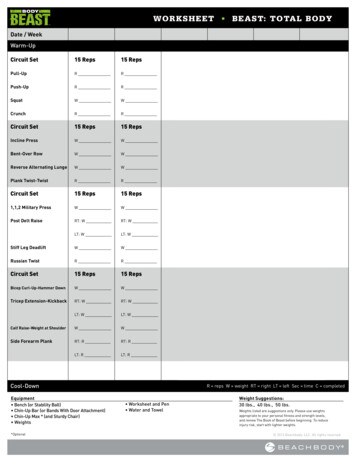
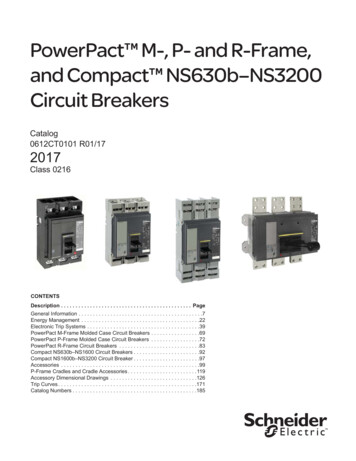
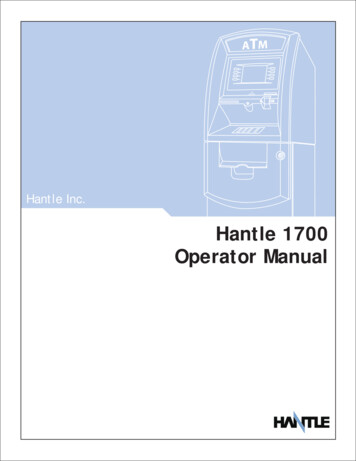
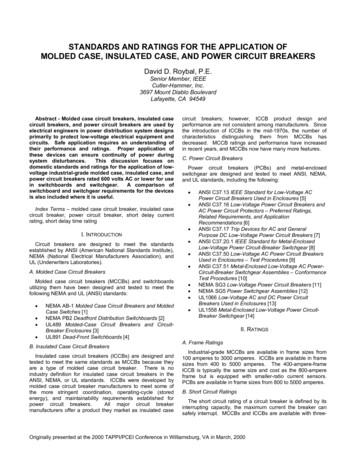
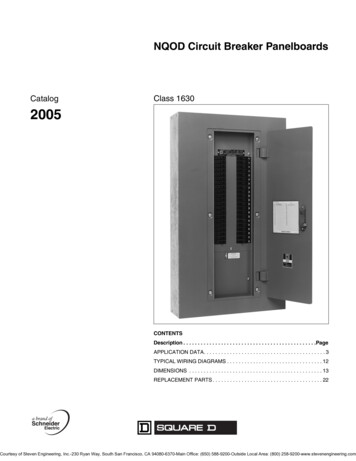
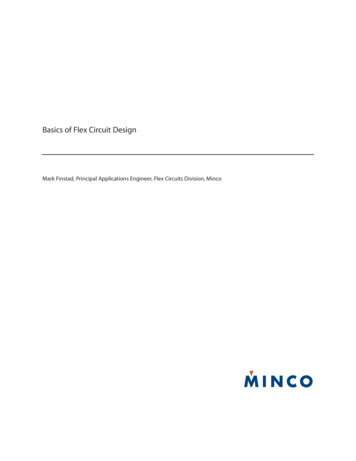
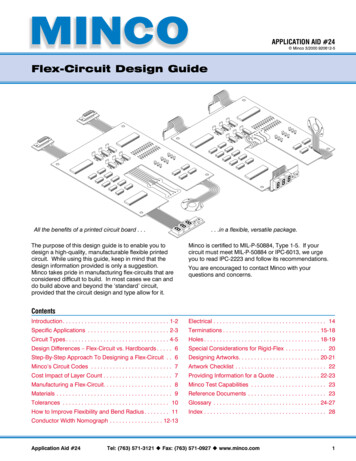
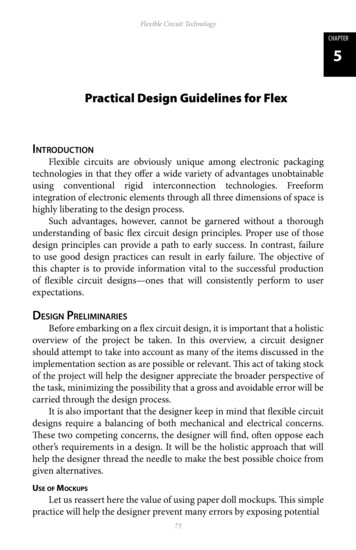


![[ ANSI C37.20 and NEMA SG-5 ]](/img/5/metal-clad-en.jpg)